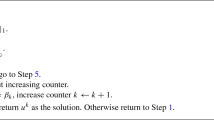Abstract
In this paper, we extend the previous method for solving inverse problems for steady-state equations using the Generalized Collage Theorem by searching for an approximation that not only minimizes the collage error but also maximizes the entropy and minimizes the sparsity. In this extended formulation, the parameter estimation minimization problem can be understood as a multiple criteria problem, with three different and conflicting criteria: The generalized collage error, the entropy associated with the unknown parameters, and the sparsity of the set of unknown parameters. We implement a scalarization technique to reduce the multiple criteria program to a single criterion one, by combining all objective functions with different trade-off weights. Numerical examples confirm that the collage method produces good, but sub-optimal, results. A relatively low-weighted entropy term allows for better approximations while the sparsity term decreases the complexity of the solution in terms of the number of elements in the basis.






Similar content being viewed by others
References
Barnsley, M. (1989). Fractals everywhere. New York: Academic Press.
Berenguer, M. I., Kunze, H., La Torre, D., & Ruiz Galán, M. (2016). Galerkin method for constrained variational equations and a collage-based approach to related inverse problems. Journal of Computational and Applied Mathematics, 292, 67–75.
Boucekkine, R., Camacho, C., & Fabbri, G. (2013b). Spatial dynamics and convergence: The spatial AK model. Journal of Economic Theory, 148, 2719–2736.
Brito, P. (2004). The dynamics of growth and distribution in a spatially heterogeneous world. Lisbon: UECE-ISEG, Technical University of Lisbon.
Camacho, C., & Zou, B. (2004). The spatial Solow model. Economics Bulletin, 18, 1–11.
Candès, E. J. (2014). Mathematics of sparsity (and a few other things). In Proceedings of the international congress of mathematicians, Seoul, South Korea.
Charnes, A., & Cooper, W. (1961). Management models and industrial applications of linear programming (Vol. 1–2). New York: Wiley.
Charnes, A., Cooper, W., & Ferguson, R. (1955). Optimal estimation of executive compensation by linear programming. Journal of Management Science, 1(1), 138–151.
Evans, L. C. (2010). Partial differential equations, graduate studies in mathematics. American Mathematical Society.
Flores Camachoa, F., Ulloa Lugob, N., & Covarrubias Martıneza, H. (2015). The concept of entropy, from its origins to teachers. Revista Mexicana de Fısica E, 61, 69–80.
Hadamard, J. (1923). Lectures on the Cauchy problem in linear partial differential equations. New Haven: Yale University Press.
Kirsch, A. (2011). An introduction to the mathematical theory of inverse problems. Berlin: Springer.
Kunze, H., & Gomes, S. (2003). Solving an inverse problem for Urison-type integral equations using Banach’s fixed point theorem. Inverse Problems, 19, 411–418.
Kunze, H., Hicken, J., & Vrscay, E. R. (2004). Inverse problems for ODEs using contraction maps: Suboptimality of the “collage method”. Inverse Problems, 20, 977–991.
Kunze, H., & La Torre, D. (2015). Collage-type approach to inverse problems for elliptic PDEs on perforated domains. Electronic Journal of Differential Equations, 48, 1–11.
Kunze, H., La Torre, D., Mendivil, F., & Vrscay, E. R. (2012). Fractal-based methods in analysis. Berlin: Springer.
Kunze, H., La Torre, D., & Vrscay, E. R. (2009). A generalized collage method based upon the Lax–Milgram functional for solving boundary value inverse problems. Nonlinear Analysis, 71(12), e1337–e1343.
Kunze, H., La Torre, D., & Vrscay, E. R. (2012). Solving inverse problems for DEs using the collage theorem and entropy maximization. Applied Mathematics Letters, 25, 2306–2311.
Kunze, H., & Vrscay, E. R. (1999). Solving inverse problems for ordinary differential equations using the Picard contraction mapping. Inverse Problems, 15, 745–770.
Moura Neto, F. D., & da Silva Neto, A. J. (2013). An introduction to inverse problems with applications. New York: Springer.
Pastor, G., Mora-Jimenez, I., Jantti, R., Caamano, A. J. (2013). Mathematics of sparsity and entropy: Axioms, core functions and sparse recovery. In Proceedings of the tenth international symposium in wireless communication systems (ISWCS 2013).
Sawaragi, Y., Nakayama, H., & Tanino, T. (1985). Theory of multiobjective optimization. Cambridge: Academic Press Inc.
Shannon, C. E. (1948). A mathematical theory of communication. Bell System Technical Journal, 27(3), 379–423.
Tychonoff, A. N., & Arsenin, N. Y. (1977). Solution of Ill-posed problems. Washington: Winston & Sons.
Vogel, C. R. (2002). Computational methods for inverse problems. New York: SIAM.
Author information
Authors and Affiliations
Corresponding author
Additional information
Publisher's Note
Springer Nature remains neutral with regard to jurisdictional claims in published maps and institutional affiliations.
Rights and permissions
About this article
Cite this article
Kunze, H., La Torre, D. Solving inverse problems for steady-state equations using a multiple criteria model with collage distance, entropy, and sparsity. Ann Oper Res 311, 1051–1065 (2022). https://doi.org/10.1007/s10479-020-03605-9
Published:
Issue Date:
DOI: https://doi.org/10.1007/s10479-020-03605-9




